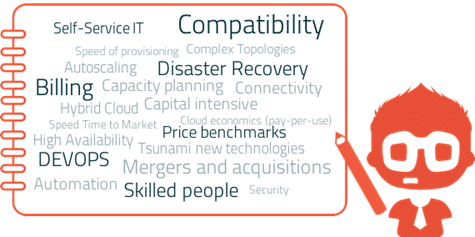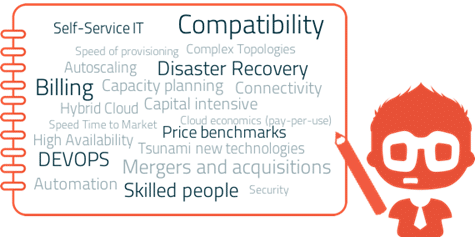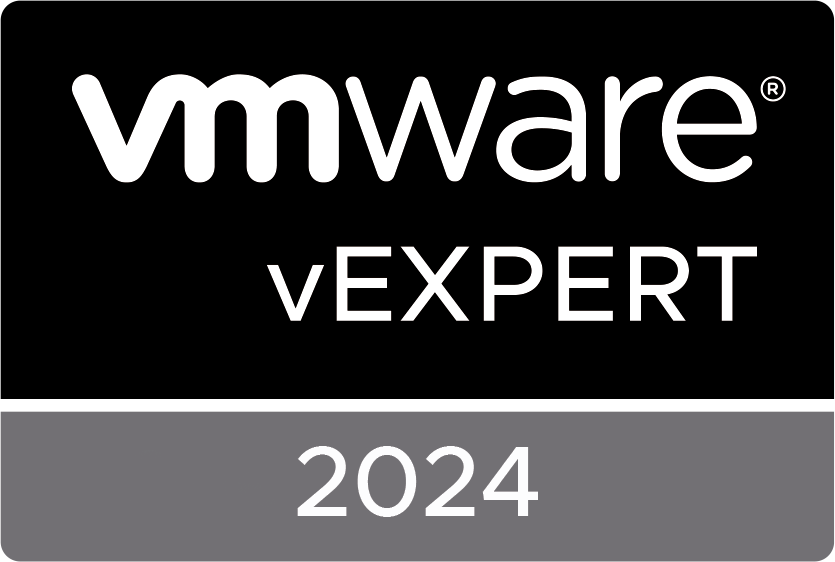As an independent consultancy company focusing on VMware technology, we work closely with numerous service providers in the vCloud Air Network program. From this perspective we see most service providers are facing more or less the same challenges or are at a pivotal turning point on a strategic or tactical level. This three part blog series will provide ITQ’s perspective on the service provider market.
No doubt everybody recognizes the extreme internal market competition service providers are facing right now. On one hand they have to battle with giants like Amazon, Microsoft, Google and VMware and on the other hand new challengers, using disruptive new technology, are already looming on the horizon. Aside from these huge challenges, service providers also have to deal with day to day and operational challenges to stay competitive. The graphic below is an unstructured collection of keywords we have picked up while working closely with numerous service providers over a long period of time. Some examples:
- We are hired primarily because of the highly skilled people we employ. We can relate to the difficulty of expanding teams with skilled people who are able to cope with all the new technologies storming our way.
- For cloud consumers, price is extremely important (while cutting costs is one of the biggest reasons for companies to adopt cloud computing, cutting costs should most definitely NOT be a primary business driver, but more on that in a future blog) so to be competitive you continuously have to benchmark your prices. Large public cloud providers have the advantage of ‘economies of scale’. This makes it easier for them to drop prices as they grow and expand their business.
- Delivering highly scalable cloud services in an instant (speed to market) means you continuously have to make high, upfront capital investments in your cloud infrastructure, while customers want to pay relative small amounts on a monthly, pay per use basis.
In their current, unstructured form these keywords are just loose words. Some will be of interest to you, some won’t. Some will relate to others, some won’t. In order to ‘enrich’ these random words so they can have a strategic or tactical purpose, it is important to group them in three key focus areas which ITQ thinks are crucial in order to be competitive in the service provider market:
Of course this is not an absolute truth or an exact science, but merely a humble opinion and a view we at ITQ share based on working ‘in the field’ with both (potential) cloud consumers and cloud service providers.
Building a brand
For service providers in general, and maybe even more so for service providers in the vCloud Air Network program, it is very difficult to differentiate from the crowd. How do you stand out? Everybody is primarily selling IaaS and maybe some PaaS services. Dutch strategist and and author drs. Wouter de Vries jr. wrote a book on service marketing called “Blauwe Bananen, Vierkante Meloenen” (ie “Blue Bananas and Squared Melons”). He gives the perfect example of how to strategically market yellow bananas. Bananas are basically the same everywhere on the world. Some might be bigger than others, some might taste slightly different, but in the end they are all the same. So how can you be competitive in selling bananas? Competing on price is basically all you can do. That’s not how you want to compete in a high-end services market such as the service provider market. In the past, some service providers made strategic choices on how to differentiate: offering high-performance computing, guaranteeing extreme high uptimes and SLA’s, etc. But to be honest, when we look at the market right now, the majority of the service providers deliver more or less the same services. Of course the big players such as Amazon, Azure, Google and VMware have been pretty able to differentiate themselves, but how do smaller, independent service providers prevent themselves from being yellow bananas? With new disruptive technologies changing the market at an insane pace, everything we observe at this moment is subject to change at any time, but right now we see three major areas in which service providers can differentiate and be competitive.
- Self-service portal
A self-service portal is your ‘directly connected interface’ to your customers. It is the first thing end users see when logging on to your service. It is your billboard, your showroom. We believe that a self-service portal should be all about customer intimacy. The customer has to ‘feel’ right at home there and they should instantly recognize your brand. In our believe it is imperative to have a branded self-service portal for your customers and it should work flawless, be intuitive to the user, perform great, and be highly available. This is especially a delicate subject for service providers in the VMware vCloud Air Network program. Their service is built on vCloud Director and VMware decided to simply stop the development of the vCloud Director self-service portal a couple of years ago. VMware delivered a set of API’s and a service provider could purchase or build any portal it saw fit. Unfortunately, not a lot of service providers had the means to either build, or the desire to buy a separate service portal. A lot of service providers are therefore still running the native, not so slick vCloud Director portal. This did create a market for companies that build awesome portals and cloud management platforms. AirVM’s AirSembly for example offers service providers a very feature rich, attractive and highly customizable cloud management platform which can be fully branded. During the writing of this article, VMware thankfully announced that they have recontemplated this strategy and that the development of the vCloud Director User Interface will be restarted in 2016. VMware also named AirVM (and competitor OnApp) ‘Recommended Cloud Management Platform Partner for VMware vCloud Air Network Cloud Providers’. They will be working closely together with VMware on integration with vCloud Director. - Speed of provisioning
Customers want services delivered instantaneously and fully automated. They do not want to send in request forms or wait for manual authorization processes. This should all be fully automated and supported by the self-service portal. - Time to market
Time to market closely relates to speed of provisioning, but has more to do with being able to integrate and deliver new, 3rd party, solutions that customers are demanding. Open API’s can be utilized to integrate these solutions and play a major role in achieving a quick time to market for new solutions that enrich your service proposition. New technologies, like VMware NSX, can be used to deliver network and security services with the click of a button. Deep packet virus inspection can be an add-on service and simply a checkmark when a customer orders a virtual machine. On the other hand, Amazon has released hundreds of new cloud services over the last couple of years. It is insanely difficult for independent service providers to compete with that. Economies of scale…
The following blogpost in this series will focus on the second area ‘controlling costs’.






